If you’re like most people, you’re breathing wrong.
I know that sounds absurd, considering we all breathe roughly twenty thousand times a day, but research indicates that in addition to breathing too quickly, we breathe incorrectly – through the mouth.
Nose breathing is one of the single best things you can do for your health, which is why it’s a little shocking that in a recent survey, 61% of adults self-identified as mouth breathers.[0]
This might not seem all that problematic – breathing is just oxygen coming in and carbon dioxide going out, right? What could really be so bad about mouth breathing?
The drawbacks of mouth breathing
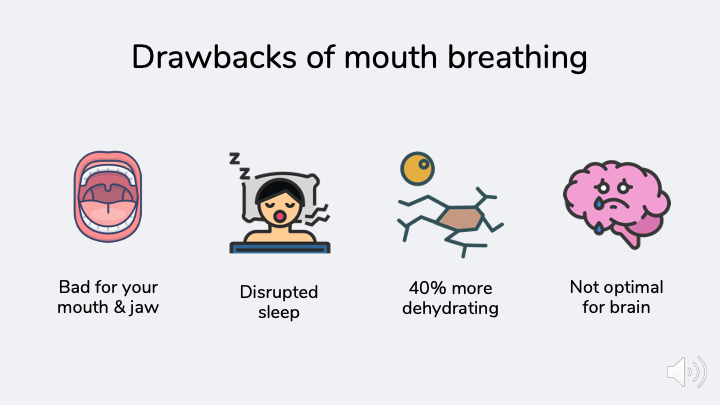
1. It’s bad for your oral posture
In a perfect world, your tongue is touching the roof of your mouth, right behind the teeth. This gives the air plenty of room to travel down the throat and to the lungs.
Unfortunately, isn’t the case with mouthbreathing:
- Your tongue naturally drops back into the back of the mouth
- The tongue now blocks air from traveling down the throat and into the lungs
- Your lungs can’t absorb enough air to deliver oxygen to all the cells that need it
You can experience this effect first-hand with a simple experiment – try inhaling through your mouth while touching your tongue to the roof of your mouth – not so easy, is it?
In addition to making it harder to breathe, poor oral posture can also lead to crooked teeth, jaw misalignment, and a whole host of other expensive dental issues, and even bad breath.[2][b]
2. It’s bad for your sleep
More importantly, mouth breathing is tied to substantially higher rates of snoring, insomnia, and sleep apnea. If you’re a mouth breather you might not even realize how much it’s impacting your sleep – 1 in 4 Americans have sleep apnea, and 80% of those go undiagnosed.[b]
That’s right, the vast majority of individuals with sleep apnea don’t know they have it, and individuals who mouth breathe are considerably more likely to have it due to the shift in oral posture.
3. It’s dehydrating
Mouth breathing is also extremely dehydrating – mouth breathing triggers the release of a hormone called vasopressin, which increases the depletion of water in the body by 40%.[b]
This might be fine if you’re doing short bursts of intensive exercise, but in a world of chronically under-hydrated individuals, mouth breathing only adds insult to the injury. Plus, vasopressin makes you more likely to wake up in the middle of the night and use the bathroom, further contributing to the link between mouth breathing and poor sleep.
4. It’s bad for your brain
Mouth breathing can also lead to an imbalance of oxygen in the prefrontal cortex, which is the part of the brain that influences decision making, focus, and social behavior. Combined with its effects on sleep, it’s no surprise that researchers are beginning to find a link between mouth breathing and ADHD.[3]
Still, the worst part of mouth breathing isn’t necessarily the immediate drawbacks, but the fact that you’re missing out on all the great benefits that nose breathing has to offer.
Related: Want to learn more about the dangers of mouth breathing? request early access to the One Deep Breath app for Android and iOS.
The benefits of nose breathing
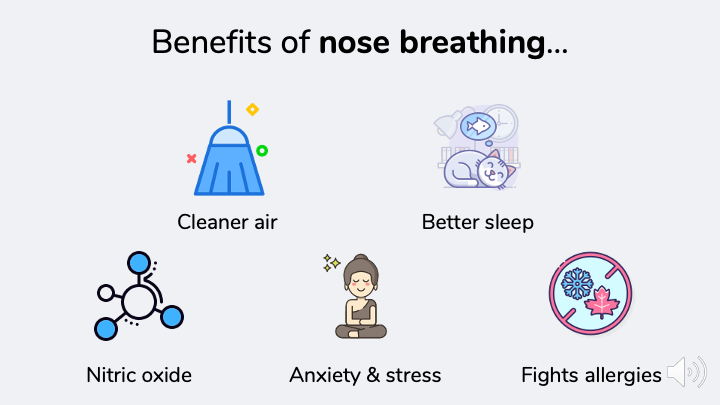
The simple fact of the matter is that we’re meant to breathe out of our nose, so it’s no surprise that there’s a ton of health benefits that come from nose breathing:
- Better air: The air produced by nose breathing is warmer, cleaner, and easier for our lungs and cells to absorb.
- Better sleep: Rates of sleep apnea and snoring are considerably lower in full-time nose breathers[4].
- Nitric oxide: Nose breathing leads to a 6 fold increase in an amazing compound called nitric oxide, which can help with immunity, mood, brain function, and sexual performance (more on nitric oxide in a bit)[b].
- Anxiety and stress: Nose breathing (especially slow nose breathing), particularly alternate nostril breathing, may even have an impact on the parasympathetic nervous system, taking us out of fight-or-flight mode and decreasing stress and anxiety so that we can stay calm, cool, and collected.[5]
- Less allergies: Nasal breathing has been proven to be an effective way to prevent and treat the common symptoms of seasonal allergies.[6]
Your body is built for nose breathing
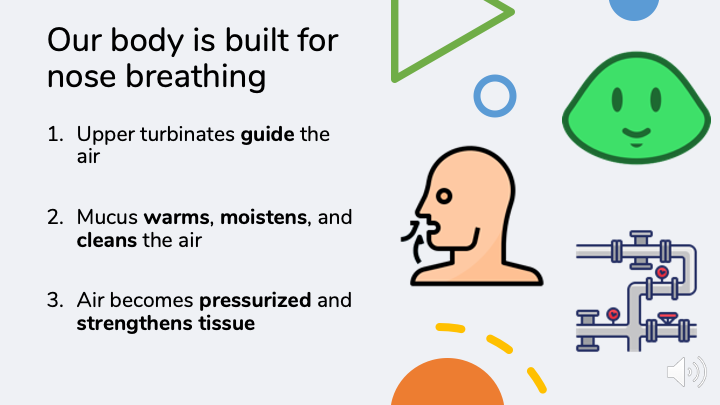
The reason nose breathing is so beneficial is pretty straightforward: while the air inhaled from mouth breathing more-or-less goes directly from outside our body into our lungs, air inhaled from nose breathing navigates a complex system of tubes and tissues in the sinuses that prepares the air for your lungs and body.
Mucus, which gets a huge amount of flack (looking at you, various mucus-thinning medications with obnoxious commercials), actually acts as the first layer of defense against outside invaders. Little hair-like structures in the nose and sinuses called cilia help guide mucus through the sinuses so that these pesky foreign agents can be disposed of in the stomach.
Meanwhile, the cold air from outside is warmed in the vast array of tubes and openings in the sinuses, which makes the air easier to absorb by the lungs and more bioavailable for all the cells that need it.
Plus, the air also becomes pressurized, which means it applies more force to the tissue around the back of the mouth and the nose, making it even easier to breathe out of your nose in the future.
You can think of it as a workout for your respiratory system – the more pressure you apply to the area, the more “toned” and less “flabby” it’ll be, making it easier to get clean, high-quality air in and out. Most importantly, this means that by breathing out of your nose, you make it easier to breathe out of your nose in the future, which is why it’s such an important habit to have.
The secret ingredient: Nitric oxide
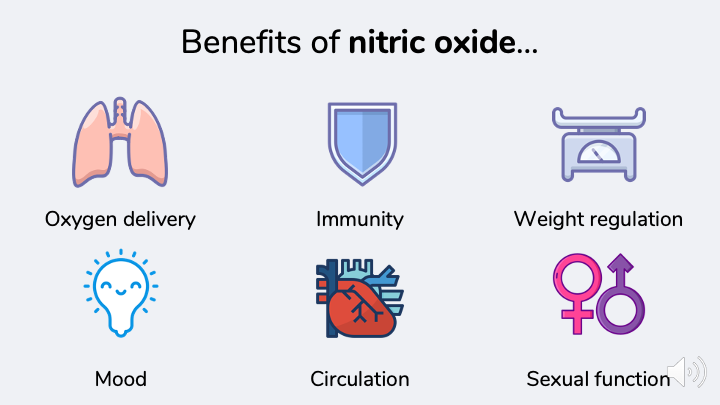
Still, we haven’t touched on the single largest reason that nose breathing is better than mouth breathing: it produces 6 times more nitric oxide than mouth breathing.[b] Nitric oxide is a powerful compound that can work wonders for our health.
During nose breathing the sinuses produce nitric oxide, a compound that has the primary role is to increase circulation and make it substantially easier for the cells to receive the oxygen they need to function. Unless we’re in extremely intense exercise, every single cell in our body relies on oxygen, so increasing the bioavailability of oxygen is a huge boost to our health.
It’s certainly part of the reason we absorb 18% more oxygen during nose breathing.[b]
But, on top of making breathing more efficient, nitric oxide has an impact on immune function, weight, circulation, mood, and sexual function. It touches just about every aspect of our health, in one way or another – and we simply don’t get enough nitric oxide when we’re only breathing out of our mouth.
Related: Check out our video on how to use a simple breathing hack to produce 15x more nitric oxide.
How to breathe out of your nose
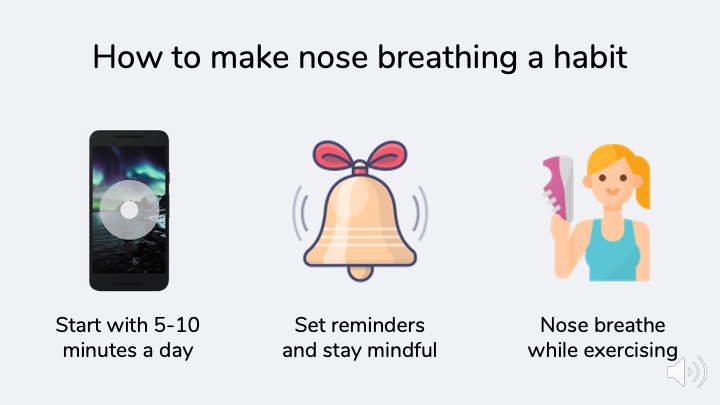
Another great thing about nose breathing is that, well, we all know how to do it.
Still, for a lot of people, nose breathing doesn’t come naturally – that’s why it’s important to start slow and make nose breathing a habit.
1. Start small
If you’re a mouth breather, start by taking 5-10 minutes out of your day to consciously breathe through your nose. I recommend following one of our guided exercises, like the Optimal Everyday pattern, which has a whole host of its own health benefits.
2. Set reminders and make it a habit
When you catch yourself throughout the day breathing out of your mouth, make it an opportunity to consciously breathe out of your nose. With the One Deep Breath app, you can also set reminders throughout the day to do this.
3. Use it while exercising
Exercise is another great time to incorporate nose breathing – if you’ve been mouth breathing for a long time, exercise will probably be a more advanced place to apply nose breathing, but try and switch to half nose and half mouth breathing, and eventually try only mouth breathing when you really need it. Over time, your nose will become stronger, and you’ll find yourself using your mouth less and less.
4. Tape your mouth closed?!?!
If you are usually a nose breather but find yourself from mouth breathing while you sleep (or you’re just feeling a bit crazy) you can try sticking a piece of tape over your mouth at night to prevent yourself mouth breathing. I know it sounds nuts, but it’s a great way to subconsciously build up the habit and get better sleep. You’ll open up the airways while you sleep, making conscious nose breathing during the day just that much easier.
5. Keep at it, it’ll get easier
Remember how we talked about how pressurized air from nose breathing strengthens tissue? The more you use nose breathing, the easier nose breathing will be. At first, you might have to make a conscious effort to nose breathe, but over time it’ll become more and more natural.
Last but not least, if you want reminders to breathe (slowly, and out of your nose, of course), you can request early access to the One Deep Breath app and set reminders throughout the day to breathe.
Sources
[b]: Nestor, James. Breath: the New Science of a Lost Art. Riverhead Books, 2020.
[0]: Breathe Right
- https://www.prnewswire.com/news-releases/new-survey-takes-a-peek-into-americans-bedrooms-to-reveal-whats-keeping-people-awake-mouth-breathing-300044836.html
- https://www.ncbi.nlm.nih.gov/pmc/articles/PMC5225794/
- https://www.ncbi.nlm.nih.gov/pmc/articles/PMC4047298/
- https://pubmed.ncbi.nlm.nih.gov/10629486/
- https://www.ncbi.nlm.nih.gov/pmc/articles/PMC5660749/
- https://www.ncbi.nlm.nih.gov/pmc/articles/PMC3392338/




